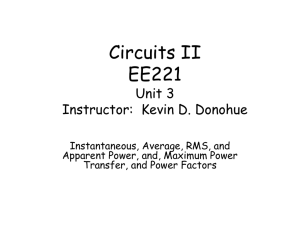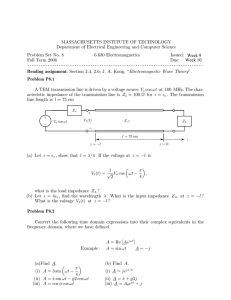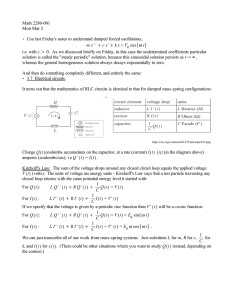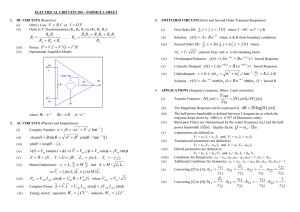Circuits II EE221 Unit 3 Instructor: Kevin D. Donohue
advertisement
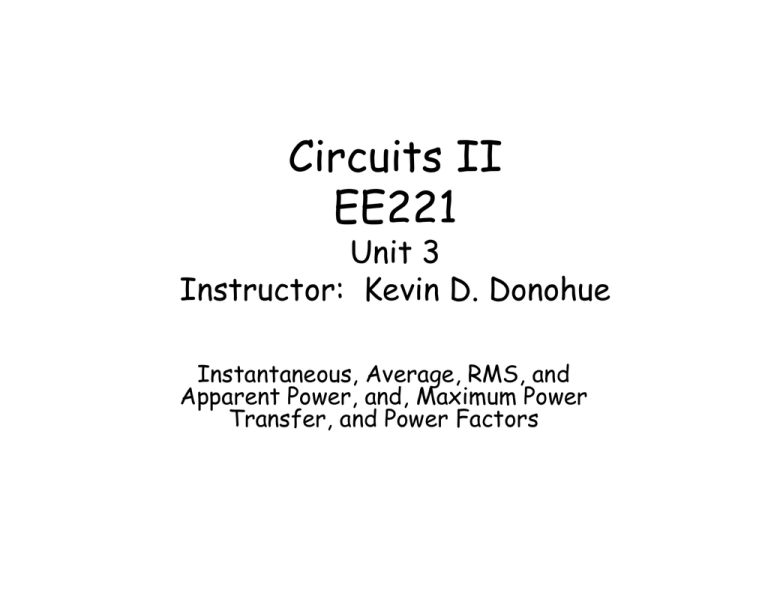
Circuits II EE221 Unit 3 Instructor: Kevin D. Donohue Instantaneous, Average, RMS, and Apparent pp Power, and, Maximum Power Transfer, and Power Factors Power Definitions/Units: Work is in units of newton newton-meters meters or joules same as energy. 1 joule j l is i work k done d f for 1 ampere passed d through 1 ohm for 1 second, or work done by y a force of 1 Newton applied pp over 1 meter. Power is a measure of the rate at which work is done and is in units ofjoules per seconds, 746 Watts in one horsepower. Power Conversion Electric motors and generators enerators convert electrical power to mechanical power and vise versa. versa Other devices exist that convert electric power to light, heat, sound, …. and vise versa Instantaneous and Average Power The instantaneous power is the power absorbed by an element at an instance of time. In an electric circuit this is given by: P (t ) v(t )i (t ) where i(t) is the current through the element and v(t) is the voltage drop over the element. Average Power over some time interval T is given by: T PAV 1 v(t )i (t )dt T 0 If the i and v product is periodic, then PAV can be reduced to the integration over a single period. For random/non-periodic d / i di signals i l T goes to t iinfinity. fi it Instantaneous Power Instantaneous power is simply computed by the product of 2 functions. For sinusoidal problems, trig identities or phasors can be used to simplify the products for easier average power formulae. formulae Example: p Write a Matlab script p that plots p the instantaneous power of a cosine voltage across an impedance load. Write the script so the voltage p can be easily y changed g waveform and impedance and instantaneous power replotted. Matlab Scripts A script is a series of Matlab command line instructions typed in a text file and stored with an *.m extension. This is referred to as an mfile. mfile To run these commands change your current directory associated with the Matlab work space to the one containing the mfile. mfile Then type the base name of the file in the Matlab command line. Or on the editor menu there is a green “play” arrow that will also execute the program. program Matlab Scripts For this example comments are included in the script, and are identified by text following a “%” % character. character The functions plot and cos are used in this script. Type help plot or help cos to get a full description f p of f these f functions in the Matlab workspace. Matlab Scripts % This script p will pplot the instantaneous ppower absorbed % by an impedance load with a sinusoidal voltage over it. % Set the parameters of the Voltage signal q y of signal g in Hz f = 1000;; % Frequency ph = 30; % Phase of signal in degrees A=2; % amplitude of signal %S impedance %Set p value zm = 8; % Impedance magnitude zp = -40; % Impedance phase in degrees % Create a time axis of 2 periods over which to plot the power tp = 1/f; % Determine period t = 2*tp*[0:5000]/5000; % Make a 5001 point time axis (row vector) over 2 periods Matlab Scripts % Create a vector of p points for voltage g v = A*cos(2*pi*f*t + pi*ph/180); % Create a vector of points for the current (adjust magnitude and phase % based on impedance i = ((A/zm)*cos(2*pi*f*t ) ( p + pi*(ph-zp)/180); p (p p) ); % Take an element by element product to get power p = v.*i; % Plot it p ( ,p) plot(t,p) title(['Instantaneous Power '] ) xlabel(['Seconds']) ylabel(['Watts']) Result Instantaneous Power 0.6 0.5 0.4 Watts 0.3 0.2 0.1 0 -0.1 0 02 0.2 04 0.4 06 0.6 08 0.8 1 12 1.2 Seconds 14 1.4 16 1.6 18 1.8 2 -3 x 10 What is the meaning of negative instantaneous power? Average Power in Periodic Signals Given a sinusoidal voltage and current in a device: v(t ) Av cos(t v ) i (t ) Ai cos(t i ) Show: PAV 1 Av Ai cos( v i ) 2 Average Power in Periodic Signals Given a phasor representation of a voltage and current in a device: Vˆ Av v Iˆ A i i Show: PAV 1 1 * ˆ ˆ Re R VI Av Ai cos(( v i ) 2 2 Conservation of Power In a given circuit the average power absorb (denoted by positive values) equals the power delivered (denoted by negative values). For a circuit with N elements the sum of all power is zero: 0 N P i i 1 Note: These are all real or average power values values. Passive Sign Convention It is assumed that positive charge entering the positive terminal of an element implies power absorbed by the element. Th Therefore, f charge h leaving l the h positive terminal of an element implies power supplied or d l delivered db by the h element. l If the words absorbed or supplied are not g given w with a p power w value, u , power absorbed will be assumed. (A negative sign will imply power suppl ed). supplied). I V I V Example Average Power Find the average power each of the elements given is(t) = 3cos(1000t)A 10ia ia 25Ω 10mH is P25Ω=34.61W =34 61W PL=PC=0 P5Ω=21.13W PCCVS=-5.54W 5 54W Pis=-50.19W 80µF 5Ω Maximum Power Transfer Given a Thévenin circuit with load ZL: Zthh Vth ZL Show that for a maximum power transfer to the load: Zˆ L Zˆ th* And the maximum power transfer is: Pmax Vˆth 2 8 Re[ Zˆ th* ] Example Maximum Power Find the impedance of the load Z to result in the maximum power transfer, transfer and find the resulting power. Assume vs(t) = 110cos(377t) V 40 F 40µF 8Ω vs Z=2.87-75.88 Z=2 87-75 88 Ith=1.6583.12A Vth = 4.71 159V Pz=3.98W 3 98W 12Ω 7.5mH Z Root Mean Square q ((RMS)) Values The RMS value of a periodic current or voltage is its DC equivalent value for delivering average power to a resistor. PAV 1 T 2 i (t ) 2 Ri 2 (t )dt R dt RI rms T T T I rms PAV 1 T 1 T T i 2 (t )dt v 2 (t ) 1 dt T R R Vrms 1 T T 2 Vrms v 2 (t ) dt T T R v 2 (t )dt RMS Formula for Sinusoids The RMS value for a sinusoid i id of f any frequency or phase is its amplitude p divided by square root of 2. I rms I rms 1 T I rms A2 T A T 2 cos 2 (t )dt 2 exp( j (t )) exp( j (t )) dt T 2 I rms A2 4T exp(( j 2(t )) 2 exp((0) exp(( j 2(t )) dtd I rms A2 4T A2 2dt T 4T A2 A 2T 0 4T 2 T exp( j 2(t )) exp( j 2(t ))dt T Apparent pp Power and Power Factor Apparent power (S) for sinusoidal waveforms is the product of the RMS voltage and current magnitudes without regard to their phase offsets. It is iin units its of fV Volt-Amps lt A s (VA) (VA). The cosine of their phase difference is the power factor (pf). (pf) 1 1 PAV 2 Re VˆIˆ* S Vrms I rms 2 v(t ) Av cos(t v ) i (t ) Ai cos(t i ) Vˆ Av v Iˆ A i Av Ai cos( v i ) Vrms I rms cos( v i ) ((apparent pp ppower)) PAV S cos( v i ) (real power) Q S sin( v i ) i (reactive power) pf cos( v i ) (power (po er factor) Sˆ Vrms I rms exp j ( v i ) (complex power) Leading and Lagging The sign g of phase p difference between the voltage and current is related to the angle of the impedance of the load. The terms l di and leading d lagging l i are used d to describe d ib this property: v i 0 pf leading (Capacitive Load) v i 0 pff lagging l i (Inductive (I d i Load) L d) v i 0 (Only Real Load) Example An industrial load consumes 10 kW at a power factor of .95 leading. The voltage across the load is 220 Vrms (assume zero phase). h ) Determine D i the h current drawn d by b the load (including phase). Result I 477.5818.2 Armss Example Find complex p power p supplied pp by y source (both real and reactive), and power factor at the source. 15 VS -j10 5kW .9 Lagging 6kVA .8 Leading + 1200 Vrms - Result Vs 1.59 24.88 kVrms pf .85 Leading S s 111 kW 68.6 kVAR
